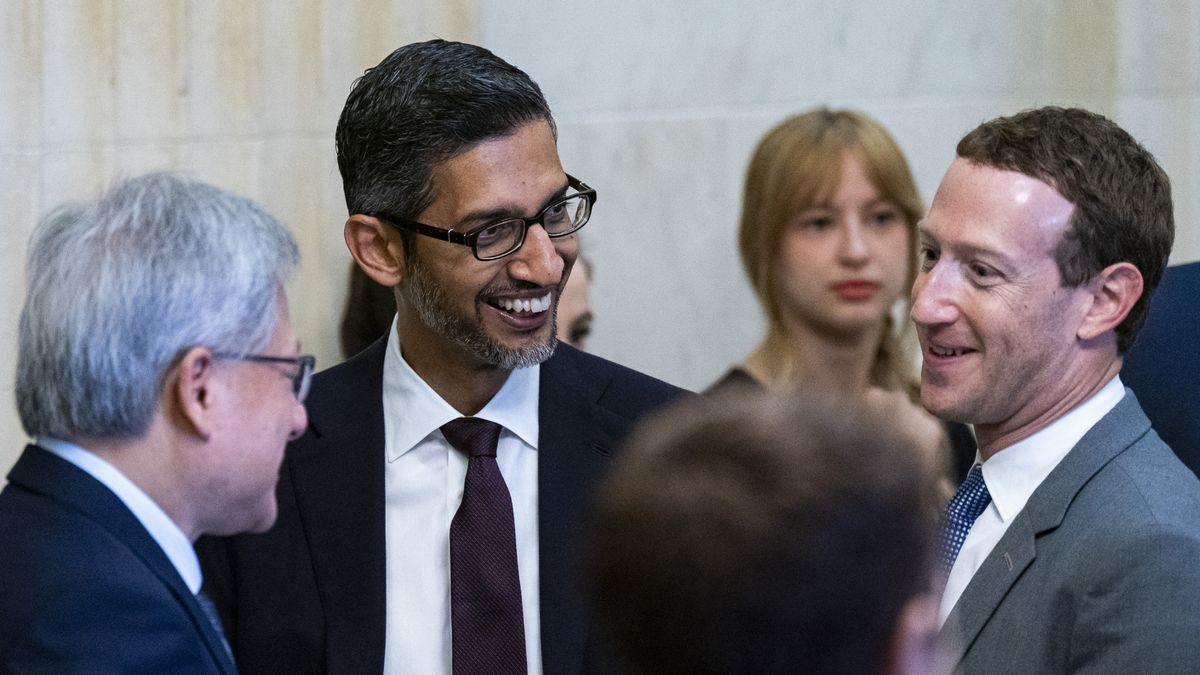Nvidia Stock: Peaking or Poised for Further Growth?
2 Sources
2 Sources
[1]
Has Nvidia's Stock Finally Peaked? | The Motley Fool
Could this be the start of a much larger sell-off in Nvidia's stock? Nvidia (NVDA -0.77%) stock has been giving back some gains lately as investors have started to pull away from high-flying tech stocks. It's still at a market cap of around $3 trillion, and Nvidia remains one of the top stocks in the world, but investors are definitely more apprehensive about buying the stock these days. While its growth opportunities are plentiful, determining a fair valuation for the stock can be difficult. Is this recent pullback in Nvidia's stock price just a temporary setback for the chipmaker, and could now be a good time to invest in the business? Or is this a sign that Nvidia's stock has finally reached a peak and that more of a decline could follow in the near future? A dip in price just isn't typical for Nvidia, which has been the ultimate growth stock to own over the past year and a half. Its sales have been tripling, demand continues to be strong, and analysts remain bullish on what lies ahead in the realm of artificial intelligence (AI). In the past month, Nvidia's stock has declined by more than 3%. The Technology Select Sector SPDR fund has also been down more than 1% during this period, as it hasn't been just Nvidia that has seen a recent pullback -- other tech stocks have also been struggling. Amazon has declined by 1.5%, and Meta Platforms has fallen by 1%, as has Microsoft. This recent bearishness doesn't appear to be limited to Nvidia's stock. And while these aren't huge declines, any sort of drop in value for Nvidia could ignite investor concerns, especially since this isn't a cheap stock to own. A big reason investors haven't been too concerned about Nvidia's rising valuation up until now is that they know the company's sales and profits will soar due to a significant increase in demand for its AI chips and other data center products. In its first-quarter results for fiscal 2025 (which ended on April 28), Nvidia's net income skyrocketed from $2 billion a year ago to now nearly $15 billion. It's not too shabby for a three-month period. That type of explosive growth can make it easy to justify paying such a steep premium for the business, knowing that the company's profits will be quite rich thanks to AI. But it's also unlikely that Nvidia will continue growing at such a high pace. In the meantime, investors still pay a hefty premium for the business. At more than 70 times its trailing earnings, the stock is priced a fair bit higher than its 10-year average price-to-earnings (P/E) multiple of 57. Investors appear to be willing to pay more of a premium for the stock than they have been in the past, but those limits have been tested in the past (back in 2021 when the P/E multiple was north of 80) before the valuation would end up coming down. A brief drop in price isn't indicative that there will be a similar pushback now, but it's a question that many investors are likely wondering about -- whether this may be the start of a much larger decline for Nvidia's soaring stock. However, I wouldn't be overly concerned, simply because its earnings are still likely to climb far higher in the future. Even if the P/E multiple investors are willing to pay for Nvidia stock comes down a bit, an increase in the bottom line could offset that and help Nvidia's valuation rise higher in the end. I don't think Nvidia's stock has peaked simply because it's still a leader in the AI chip market. While there will be rivals down the road that will try to take some market share from Nvidia in the future, it has built up such a strong position that it could take a while before that happens. As long as companies continue to spend heavily on AI, Nvidia's results may continue to remain impressive in the foreseeable future, given its dominance in the industry. Until there's a crack in Nvidia's armor that suggests demand is starting to waver or there's an increase in competition on the horizon, this can still make for a good stock to buy and hold right now.
[2]
Prediction: Nvidia's Stock Correction Will Lead to Outsized Gains in the Second Half of 2024 | The Motley Fool
Investors would be wise to follow Warren Buffett's sage advice. Beginning in January 2023, it seemed like Nvidia (NVDA -0.77%) stock went straight up for almost 18 months. There was good reason for that as investors piled in to the company that has become the face of a dramatically increasing artificial intelligence (AI) sector. But no stock goes straight up forever, and valuation still matters. A correction in the stock was inevitable and finally occurred over the last month. Nvidia shares recently traded as much as 13% below the closing record high set on June 18. And buying quality stocks in periods of corrections or bear markets is one of the best ways to generate market-beating returns. The recent pullback isn't the first time Nvidia investors dragged the stock lower by taking profits. In the second half of 2022, Nvidia's sales plunged nearly 20% compared to the prior-year period as chip demand from gaming and cryptocurrency-mining users crashed. That helped lead to a sell-off that knocked Nvidia shares down by more than half in 2022. Those sellers missed out on what would become an epic stock price run with gains of nearly 750% since the start of 2023. That's because Nvidia kept innovating. Sales to its data-center customers exploded as generative AI gained prominence, and the company's gaming sales rebounded. A more recent hiccup for Nvidia's sales has been government restrictions applied to advanced chips being sold to China. But recent reports say that Nvidia is getting ready to offer a new chip for sale to China that conforms to current trading rules. A new AI chip for the Chinese market that adheres to U.S. export controls would be just one more catalyst for Nvidia's sales, and potentially share price, to rise. That's why it's a good idea to take advantage of the recent price drop. As Warren Buffett famously said of his investing philosophy, "we simply attempt to be fearful when others are greedy and to be greedy only when others are fearful." The recent correction shows that some Nvidia investors are fearful right now. In addition to the anticipated rebound in Nvidia's China sales, its domestic data center sales should also provide future catalysts. The main driver to boost sales will be its next-generation Blackwell platform for the growing data center market. Nvidia has said it will introduce new chips on an annual cadence. But the newest technology chips should actually be incremental income, rather than a replacement of existing income. One bit of evidence was the recent second-quarter report from Taiwan Semiconductor. The manufacturer of high-end AI chips for Nvidia said that demand remains strong and supply continues to be tight. That bodes well for continued growth in Nvidia's sales. Nvidia's business plan is also helping to increase demand. The company has already built a dominant position supplying chips to train AI models. It has also begun an annual cadence of new, higher-perfomance offerings beginning with next year's Blackwell graphics processing units (GPUs) and AI server-infrastructure systems. Its biggest customers will likely continue to upgrade with Nvidia's newest products. But don't forget that smaller companies still struggling to obtain Nvidia's existing H100 GPUs remain in the queue. KeyBanc Capital Markets analyst John Vinh summed it up well in a recent research note, stating: "Despite the impending launch of Blackwell in 2H24 [second half of 2024], we are not seeing any signs of a demand pause as demand for H100 remains robust, as we continue to see rush orders." Nvidia is expected to update investors with its next quarterly financial report on Aug. 28. If it confirms the continued strong-demand picture by outpacing expectations yet again, it would likely boost the share price. But Nvidia's stellar results have continued to build investor expectations, some of which are already priced into the stock. Nvidia's forward price-to-earnings (P/E) ratio is hovering above an already high five-year average. That high valuation will likely continue if the company's sales continue to soar. But investors should be prepared for another correction if the company reports any stumbles to that growth.
Share
Share
Copy Link
Nvidia's stock performance has been a hot topic among investors. While some believe it may have reached its peak, others argue that the correction is over and the stock is set for continued growth.

Nvidia's Meteoric Rise
Nvidia Corporation, a leading player in the semiconductor industry, has experienced an extraordinary surge in its stock price over the past year. The company's shares have skyrocketed by an impressive 223%, far outpacing the broader market and even its tech peers
1
. This remarkable performance has led many investors to question whether Nvidia's stock has finally reached its peak or if there's still room for growth.Concerns of Overvaluation
Some market analysts argue that Nvidia's current valuation may be stretched. The company's price-to-earnings (P/E) ratio stands at a lofty 108, significantly higher than the S&P 500's average of 26
1
. This elevated valuation has raised concerns about the sustainability of Nvidia's stock price, especially in light of potential market corrections or economic headwinds.AI Boom Fueling Growth
Despite valuation concerns, Nvidia's growth prospects remain strong, largely due to its dominant position in the artificial intelligence (AI) chip market. The company's data center revenue, which includes sales of AI chips, surged by 141% year-over-year in the most recent quarter
2
. With the AI industry still in its early stages, Nvidia is well-positioned to capitalize on the growing demand for AI-related hardware and software solutions.Recent Stock Correction
Nvidia's stock recently experienced a correction, with shares falling by 19% from their all-time high
2
. However, some analysts view this pullback as a healthy consolidation rather than the beginning of a prolonged downturn. They argue that the correction may have created an attractive entry point for investors looking to gain exposure to Nvidia's long-term growth potential.Related Stories
Future Growth Catalysts
Several factors support the argument for Nvidia's continued growth. The company's leadership in graphics processing units (GPUs) for gaming and professional visualization remains strong. Additionally, Nvidia's expansion into autonomous vehicles and edge computing presents new avenues for revenue growth
1
. These diverse growth drivers suggest that Nvidia may still have significant upside potential.Investor Sentiment and Market Dynamics
While some investors remain cautious due to Nvidia's high valuation, others are bullish on the stock's prospects. The company's consistent ability to innovate and adapt to emerging technologies has earned it a loyal investor base. Moreover, the ongoing AI revolution and Nvidia's central role in powering AI applications continue to generate excitement among both retail and institutional investors
2
.References
Summarized by
Navi
[1]










